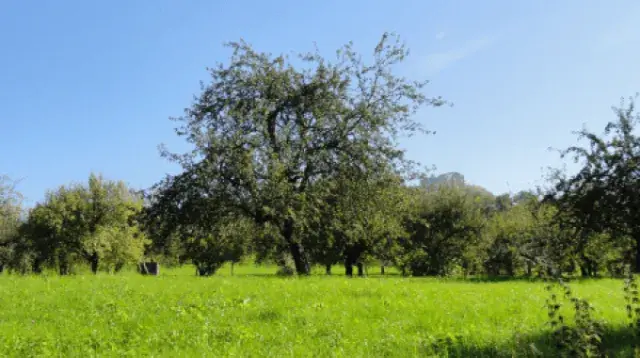Biodiversity in the garden
Whether vegetable, ornamental or public, little corners kept to ourselves or shared with neighbours, our gardens are often our most cherished spaces. And though it may be humans who start the process, left to their own devices, gardens can thrive.
Biodiversity takes root in our gardens. The richer and more varied they are, the more they boost harvests, keep the soil healthy and repel pests. They breathe life into little slithers of land and are the best assistant any gardener could ever wish for. As long as you treat them right!
Biodiversity, the engine room of every garden
Gardens are cultivated ecosystems. Unlike natural ecosystems, we intervene by choosing and organising the plant species we want to include. But that doesn’t stop other species from spontaneously moving in! These are the factors that determine how healthy your garden is by initiating exchanges on every level.
Nature helping nature
In our gardens, biodiversity isn’t measured by the number of different species living there, but rather the diversity, quality and richness of their exchanges. As every gardener will tell you, plants and animals work together to maintain a healthy ecosystem. Earthworms aerate the subsoil and prevent it from becoming too compacted. Weeds help keep the surface moist and slow down evaporation. Even passing birds help to refresh the soil cover and spread seeds. Plants also help each other and combine their efforts. For example, nasturtiums attract aphids, which keeps them away from radishes, tomatoes and courgettes. Aphids won’t go anywhere near lavender, but that’s a favourite of bees, who help melliferous plants and flowers thrive. Other plants repel pests, help maintain the soil’s composition, retain moisture for their neighbours or, on the contrary, help dry the soil out to prevent root rot..
Biodiversity mix
The more species there are, the more they work together and the more the ecosystem maintains its balance. A balanced ecosystem is one that’s long-lasting, stable and resistant. This is the whole principle of permaculture, which seeks to limit human intervention and instead rely on the natural role played by different species. As well as being a small refuge for local biodiversity, gardens also act as a link for entire regions, providing a chain between different ecosystems and allowing their own biodiversity to flourish.
Each type of garden cultivates its own biodiversity mix:
– Vegetable gardens
Carrots, courgettes, tomatoes, lettuce, radishes... the composition of a vegetable garden largely depends on the climate and individual tastes. Nowadays, we’re quickly rediscovering old species or “forgotten vegetables” , such as cardoon, parsnip, Jerusalem artichoke and swede, at the same time as reintroducing wild species, such as goosefoot. Though often designed for food production, vegetable gardens are an excellent way of cultivating a much wider range of biodiversity than just vegetables alone. Flowers, grasses and shrubs all enrich the environment and help maintain a healthy balance.
– Herb gardens
Often found close to kitchens, herb gardens are sometimes not even planted in the ground. Rosemary, thyme, sage, basil, chives, mint and fennel can all be found here, depending on the plant’s need for water, light and sunlight.
As well as being invaluable in the kitchen, herb gardens can also be useful for medicinal purposes, as were common in medieval times, featuring plants like verbena, camomile, mint, fennel and star anise, all known for their many different uses and benefits. But it’s always best to do your research or seek expert advice before playing the chemist!
These plants, most of which are melliferous, are real magnets for bees and pollinating insects. A great way to encourage biodiversity, even on a windowsill!
– Ornamental gardens
Designed to be pleasing on the eye, but also to help balance a garden, ornamental gardens are cultivated for their flowering plants in a thousand different shapes and colours. Grasses, perennials, vines, climbers and creepers bushes, ground covers... the variations in species are endless, and that’s just as well – you can never have too much diversity!
– Fruit gardens
Fruit gardens are often a childhood favourite, featuring the likes of strawberries, raspberries, blackcurrants and gooseberries on bushes, plus apricots, mirabelle plums, apples and cherries on trees and shrubs... Biodiversity thrives among these species, ensuring healthy soil and quality visitors! (Link to orchard biodiversity)
Taking care of garden biodiversity
Often kept under close surveillance by amateur gardeners, parasites can threaten garden biodiversity. However, overuse of plant protection products to get rid of them can be an even bigger threat. But the risks are even greater in the absence of biodiversity. Playing a relay role between ecosystems, especially in urban environments, gardens are precious refuges for biodiversity that would otherwise have nowhere else to go.
Whether it’s a window box on a windowsill, a potted plant on a tiny balcony, a vegetable patch in the shade of a garage – it doesn’t take much to help biodiversity thrive. People are often surprised by the sudden enthusiasm for gardening that can take hold with just a little effort.
Planting plants that require a lot of water in an area that experiences major droughts may not be the best idea. As far as possible, opt for local species that are already adapted to your environment and avoid invasive exotic species. Ask your garden centre or local gardeners for advice to help you make the right choices. And make sure you know what you’re doing before pulling up any roots, weeding or mowing indiscriminately. Some species are real pillars of the ecosystem you’ve helped create, and it would be a shame to get rid of them through ignorance! You could also check the list of endangered plants in your region, in case one of them has taken up residence in your garden!

Encouraging biodiversity with high-stem orchards
High-stem orchards, also known as orchard meadows or eco-groves, take their inspiration from traditional orchards. The principle is to combine fruit trees with meadow plants at a limited density. This careful balance encourages plant species to multiply, including herbaceous plants, buds and flowers, dead wood, etc., alongside animal species, which come here to find shelter, support and food. A high-stemmed tree is a fruit tree grafted at a height of two metres onto a rootstock that gives it greater strength and resistance. Combined with other types of crops or livestock, these orchards provide essential services, such as protection from the wind or erosion, contributing to the soil quality, offering denser grazing and more. They can therefore be introduced in any type of environment to enrich biodiversity!

Biodiversity is all around us!
Find out more about forest biodiversity
